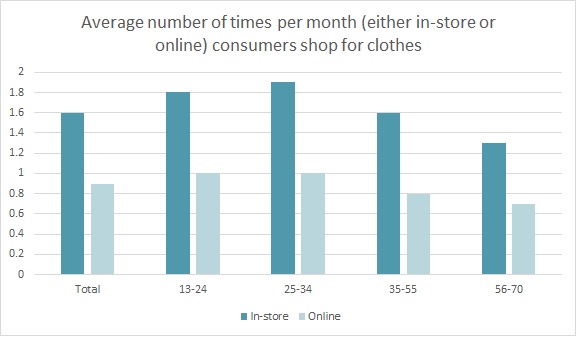Apparel shopping was once engaged in regularly as something social or to pass time on the weekends. Now it can be done during meetings, in class, while waiting for Starbucks…literally around the clock thanks to mobile apps or online sites. While that sounds great for retailers, it’s also created customers that are more educated and, like someone who robotically swipes left in their search for the perfect date, pickier than ever. That means online purveyors have to offer more personalized product to attract and retain these shoppers.[quote]
At the recent Oracle + Bronto Commerce Marketing Spotlight event in New York, Bronto Software’s Carolyn Sparano, general manager, said major advances that will individualize customers will be the next wave in retailing.
“We’re seeing artificial intelligence being used to power chatbots that automate the customer service experience,” Sparano said. “And now, with virtual online dressing rooms, we can try on clothes without even leaving the house. We’re seeing the Internet of Things, the internet of everything — Alexa, wearables, smart refrigerators, self-driving cars. But you know what really works is when you have technology not for the sake of technology but to help your customers love your products even more.
“The question is, do you know what to invest in now to be ready for the future?” Sparano asked. “Simply put, the answer is data. The marketer of the future will be looking to reevaluate their customer’s journey and look at all the data together so we can treat the customers as individuals rather than treating them like one of the crowd.”
On average, consumers shop for clothes online about once a month, according to the Cotton Incorporated Lifestyle Monitor™ Survey. That compares to 1.6 times per month in-store.

Most ecommerce shoppers say they prefer to buy clothes online because they find it easier (42 percent) and convenient (20 percent), according to the Monitor™. They also feel they can find a better selection online (18 percent), find cheaper/better prices (11 percent), it’s faster (11 percent), and they avoid the crowds (7 percent).
About 4 in 10 consumers typically start browsing for clothing ideas online through retailer or brand websites (41 percent), followed by search engines (28%), brand emails (24 percent), and apps (18 percent), according to Monitor™ data. Women are significantly more likely than men to start browsing for apparel ideas online through retailer or brand websites and Pinterest, while men are more likely to use search engines.
Eloquii’s Kelsey Foy, director of retention marketing for the plus-size, fast fashion online retailer, says the company uses email to take a persistent — not pesky — approach to reaching new customers.
“We want to educate her and we want to give her exclusive offers,” she said at the Oracle + Bronto Commerce Marketing Spotlight. Eloquii helps educate and connect with shoppers through blog posts on its site that feature regular customers.
“We’ll fly a customer into our office, do a photo shoot with hair and makeup, and we have a whole blog post on them,” Foy said. “Customers love this as part of our content.”
This effort to engage and inform is important, as the Monitor™ research finds 7 in 10 consumers say they tend to shop brands they know and trust online rather than new brands.
If Eloquii’s potential new customers don’t “convert” — or make a purchase within three days — they’re sent a $25 coupon code to incentivize them. “Our gal loves a good code, and it gets our customers to activate.”
Three days later, if shoppers still haven’t made a purchase, “We hit them up with a ‘last chance’ message letting them know their promo code is expiring, hoping that the expiration messaging will create some urgency. Then, if they still haven’t acted, we highlight everything about our fit.”
Ecommerce apparel retailers may want to emphasize fit more, as about 7 in 10 consumers are concerned about tactile issues such as not knowing whether clothes will fit (83 percent), not being able to try clothes on (78 percent), apparel quality (74 percent), and not being able to touch the pieces (72 percent), according to Monitor™ research.
Further, the Monitor™ found more than 7 in 10 consumers say detailed sizing information (76 percent), up-close product views (73 percent), multiple color views (72 percent) and detailed fit information (71 percent) would be influential in their ultimate decision to purchase a clothing item online.
Foy says Eloquii has as many people on its fit team as its design team, something that means a lot to the plus-size customer.
“We actually have an in-house fit model that is with us five days a week. And we have fitting sessions three times a week for four hours. We feel that’s pretty unique to us, and we want to highlight it in our emails.
Whether it’s fit, product selection or free shipping, stores should play up anything that sets them apart. (Monitor™ research shows 54 percent of all consumers won’t buy clothes online if they have to pay for shipping.) In a sea of retail, half of all consumers shop for clothes online through Amazon (48 percent), according to the Monitor™. That’s followed by sites for chain stores (44 percent), mass merchants (42 percent), and department stores (32 percent).
“With the Amazon’s of the world it’s easy to get a lot of things in a few days,” Foy said. “So it’s important to highlight what’s unique about your business and create a personal touch with your customer because that will go a long way.”
